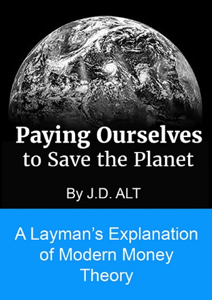By J.D. ALT
The
theme and illustrations of this essay are from the new book “Paying Ourselves to Save the
Planet.”
It
might seem, as we observe the U.S. government “instantly” generating $2
trillion new dollars for direct payments and grants to people and businesses,
that the coronavirus pandemic has shed a new light on the authenticity (and
necessity) of modern money theory (MMT). But that light, if it is being shed at
all, is illuminating instead the dramatic limitations of the “standard money
theory” we insist on applying to the exigencies of an unfolding modern society
(including, but not limited to, how to deal with pandemics).
What
do I mean by “standard money theory”? I mean a very simple assumption
implicitly built into our mental models of how money works: namely, that the






